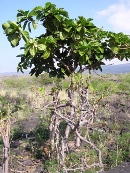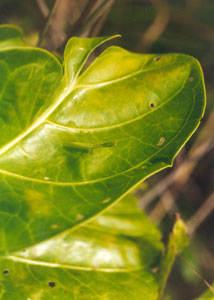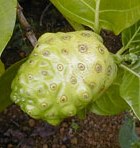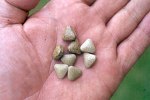Interactions
Diseases and Pests
Cows, pigs and horses like to graze on M. cirtifolia leaves. Mice and rats love to munch on the fruit and stems of young seedlings. Both of these things can stunt noni plant growth.
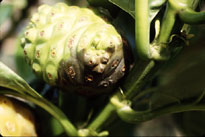 A new organism, called Phytophthora morindae,
has been found to cause black flag on noni. This
organism causes black spots of the leaves, stem, and
creates blackened soft spots on the fruit. This disease
also creates severe defoliation, but the roots and
woody portions of the plant are not usually affected. This disease seems to only occur
in specific area and prefers high humidity, frequent
rains and high winds. Its spores are spread via
water or wind.
A new organism, called Phytophthora morindae,
has been found to cause black flag on noni. This
organism causes black spots of the leaves, stem, and
creates blackened soft spots on the fruit. This disease
also creates severe defoliation, but the roots and
woody portions of the plant are not usually affected. This disease seems to only occur
in specific area and prefers high humidity, frequent
rains and high winds. Its spores are spread via
water or wind.
The root-knot nematode is a big problem when
cultivating and growing noni. This parasitic
nematode has a wide range of hosts and can infect
multiple plant species. They can survive for
extended periods in the soild in Hawaii without a
host. These nematodes infect young noni roots and
make the roots the swell and create galls that crack
open; once the roots are cracked, it allows bacteria
and fungus to enter the roots. The best way to avoid
this is to start young noni in sterilized soil.
Aphids and Ants like to feed on the sap of the noni plant and cause stunted growth, leaf curling and deformity. The waste that the aphids excrete provide an excellent food source for saprophytic fungus that causes "sooty mold". Once the aphids are eradicated the mold will usually disappears as well.
Croton caterpillars like feed on leaves of young
noni trees. These caterpillars consume most of the
foliage leaving large gaping holes in the leaves.
It also feeds on many different species of plants
including the castor bean and croton; occasionally
this caterpillar will inhabit cabbage, macadamia,
mustard,
bananas,
roses,
sugarcane and
tomatoes.
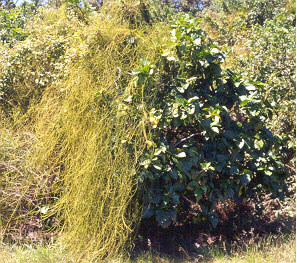
Cassytha filiformis is a parasitic vine that
grows on noni and steals nutrients from its foliage.
This vine is found on all the major islands except
Kaho’olawe. This parasite inhabits 15 different
species of plants in Hawaii, including the noni.
Cassyntha like low-lying costal plants.
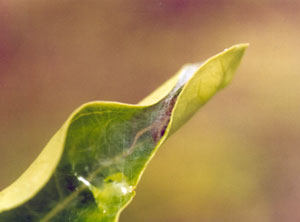 There are a few species that help the noni and
help get rid of some of these pests that like to eat
the noni. A well camouflaged preying mantis sits on
a leaf and waits for its dinner to arrive (left);
while a spider builds its web on another leaf to
catch nasty pests (right).
There are a few species that help the noni and
help get rid of some of these pests that like to eat
the noni. A well camouflaged preying mantis sits on
a leaf and waits for its dinner to arrive (left);
while a spider builds its web on another leaf to
catch nasty pests (right).
Another important beneficial organism is the lady beetle. Because the ants protect the aphids from predators, its hard to get rid of such pests with out pesticides, but these ants have one foe that they cannot protect the aphids from...the lady beetle.
To see more interactions between the noni and other organisms click here.
